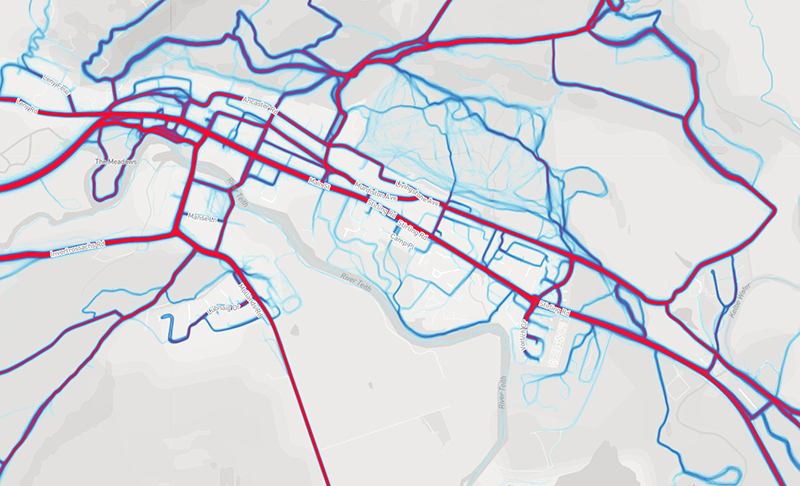

Getting Around
Traffic, and pedestrian networks
A survey carried out for Callander Landscape Partnership in 2019 told us that the average daily traffic flow between Callander and Kilmahog was ‘6530 vehicles, or 272 vehicles per hour with greater peak flows. During the day/holidays/weekends.’ This count would exclude local short trips between the traffic flow monitors.
Without air quality monitoring it’s impossible to know if emissions from the traffic moving along the A84 affect the health of pedestrians and cyclists but it is worth considering that the Main Street, between the Roman Camp and the Meadows, is a corridor with buildings on both sides, potentially acting as a trap for vehicle emissions.
A 2018 study carried out in Crieff, which has a similar corridor along its High Street and similar volumes of traffic, found that nitrogen dioxide and fine particle emissions breached Air Quality Regulations and an Air Quality Management Area order was imposed.
In their strategy Cleaner Air for Scotland (2015), the Government set out its Placemaking ambition for: ‘A Scotland where air quality is not compromised by new or existing development and where places are designed to minimise air pollution and its effects.
This August (2021) Stirling Council agreed to monitor air quality in the town. The results should be available before the public consultation for Callander’s Place Plan. We will keep you updated.
Placemaking
Placemaking is a central pillar of Government Policy and will form an important part of our Local Place Plan. ‘Placemaking is a process through which places that people want to live, work or explore are created’
Scottish Government Placemaking Policies (PDF)
Each Planning Authority must draw up a placemaking strategy. It was interesting to discover that LLTTNP’s 2018 placemaking strategy focussed predominantly on new build housing.
The Park’s approach is that any ‘green networks’ (interconnecting pedestrian and cycle routes) must be provided by property developers .
Importantly, the Government plans to set out, in Scotland’s fourth National Planning Framework (NPF4) that an infrastructure-first approach will be included into the framework. NPF 4 goes out for consultation later this year and so will play an important part in this consultation. This means that pedestrian and cycle access must be in place before any new housing is built.
Our community has been asking for a footbridge over the Teith and better connectivity between the east end of the town and the high school since 2008. With plans to build the new primary school at the McLaren campus now under consideration the need for safer, better, footpaths will become more acute.
20-Minute Neighbourhoods
These are places designed to enable residents to meet their day to day needs within a 20-minute walk of their home through access to safe walking and cycling routes, or by public transport. The Scottish Government is committed to working with local government to take forward ambitions for 20-minute neighbourhoods for Scotland.
Is Callander a 20-minute neighbourhood?
The short answer no, unless you have excellent fitness or a bicycle.
Using Google Earth to calculate average walking times we found that:
The top end of Mollands estate and the new RSH houses is around 1.1 miles to the nearest supermarket (24-30 minutes) and 1.8 miles (30-40 minutes) to the Medical Practice.
At the west end of town, Leny Feus is just 800 yards to the nearest supermarket but 1.5 miles (25-35 minutes) from the medical centre.
At the east end, the walk from Vorlich Crescent to the primary school is currently 1.2 miles (25-30 minutes) and the walk to the McLaren Campus is 1.5 miles (33-40 minutes).
How could Callander become a 20-minute neighbourhood?
Upgrading Footpaths on both banks of the Teith and building a pedestrian bridge would make a 20-minute neighbourhood more achievable. Substantial improvements to the existing core footpath network (most significantly, the Creep) would also be necessary.
If the footpaths along both side of the river were made fully accessible and a pedestrian bridge created between the Camp Place field and the opposite bank of the river it would cut the walking distance between the A81 housing and the medical practice by 50%. At the east end, the walk between the existing primary school would remain much the same but would avoid traffic along the Main Street. The walk to the McLaren Campus would be reduced to 1 mile, saving around 20 minutes each trip.
Disabled Access
In the last CAP, we wanted Callander to become more accessible for those living with disabilities. Since then, the Callander Access group were successful in their application for handrails, grab rails mand ramps for Main Street businesses.
CYP now has a fully accessible self-catering pod which was designed with help from local wheelchair users, Woods Leisure now has an accessible caravan for holiday makers and the Leisure Centre has plans to install a fully accessible Changing Place facility. We are getting there but one problem remains – that of poorly surfaced foot paths and pavements and unsafe access routes.
We have asked some wheelchair users to test the accessibility of our streets and paths and will update this page when they have told us what they discovered.
Active Callander
Callander residents are an active bunch. We like running, cycling, swimming or a more leisurely walk in our beautiful surroundings, as do many of the people who come to stay in the town. But where do we go to exercise and are we making the most of our landscape? We looked at heatmaps from Strava which track users as they move around. Strava is fitness tracker app and is used by an estimated 10% of our adult population.
Where we exercise
This map shows where Strava users run, walk, cycle and swim. The most noticeable points are the popularity of the National Cycle route 7 running through Loch Venachar, to Lochearnhead, and beyond. Also popular are the routes along Bracklinn Road and Livingstone Avenue to Bracklinn Falls and up past the Scout’s Pool. The Main Street and The Meadows are busy, as you would expect, but the inaccessibility of the path on the south bank of the Teith means it virtually unused. On the north bank, the route from the Stirling Road Field to Camp Place Park does get moderate use and Callander residents have created their own walking routes where no formal pathway exists.

Strava activity heatmap for Callander ©Strava 2021
Cycling
We know that use of cycle paths in Callander increased during 2020. In one case, Glen Gardens, 179% more cycle rides were taken between March 2019 and March 2020. During the Covid lockdown many of us took dusted off our bikes and took to the roads and cycle routes around town. In May 2021, Callander was awarded a Silver Cycle Friendly Community Award from Cycling Scotland and recently more bike parking stands have appeared around the Main Street.
Public Transport
The introduction of fare-free bus travel for those under 22 (from January 2022) is a welcome move. When this initiative comes into force it will allow at least 30% of Callander residents (including those aged over 60 or those living with disabilities) access to free bus travel.
The main barrier to taking the bus to Stirling is price. Current fares are 40p per mile for a single ticket and 35p per mile for an adult return (adult single fare £6.30, return £10.70). If you need to go the hospital in Larbert the overall price per mile will be 92p per mile single and 79.39p per mile return (adult single £10.89, return £18.60)
People whose workplace does not fall along the 59 bus route must either drive to work or drive and take a train from Stirling, Dunblane or Bridge of Allan.
Looking at our daily commute to work, data taken from the 2011 Census and analysed by Datashine tells us that 41% (635) of employed residents within the town boundary worked out with Callander and 377 people commuted into Callander for work. 96% of those who worked out with Callander commuted by car.
Electric Vehicle Infrastructure
The UK Government has announced the phase out sales of new petrol and diesel vehicles by 2030 to be replaced by electric vehicles. Currently, national average figures suggest that 80% of EV users charge their vehicles at home overnight, while 34% of households do not have off-street parking and need to charge on-street or elsewhere. Callander is also a tourist town, being a stop-over for long journeys likely to form a natural recharging point. In 2021 Callander has 5 public charging points . This doesn’t scale up to service the expected growth in electric vehicles by the end of the Local Place Plan period.
It is within the National Park’s power to introduce a planning condition requiring any new-build houses to include the provision of EV charging points.
In larger developments of homes without private driveways communal access can be provided using the streetlighting network.
For houses with driveways, an EV charging point could be installed within the curtilage of the property


